How Can We Help?
Scenarios
A scenario is a .dirpkg file created and edited in DataMesh Studio that consists of multiple scenes, each containing user-added models, pictures, attachments, text, tools, etc. In a scenario, you cannot only compose and structure each scene but also animate dynamic transitions between the scenes. Scenario management is available in the Digital Assets module of the DataMesh FactVerse platform.
Create a new scenario
To create a scenario, click the New Scenario button on the homepage. By default, each new scenario includes one light and one camera.

If a scenario file is already open, you can create a new scenario by clicking on the File menu and selecting New Scenario. Note: In this situation, you will be prompted to save the currently edited scenario.

Open a cloud scenario
To open a cloud scenario, follow these steps:
1. Click Open on the homepage.
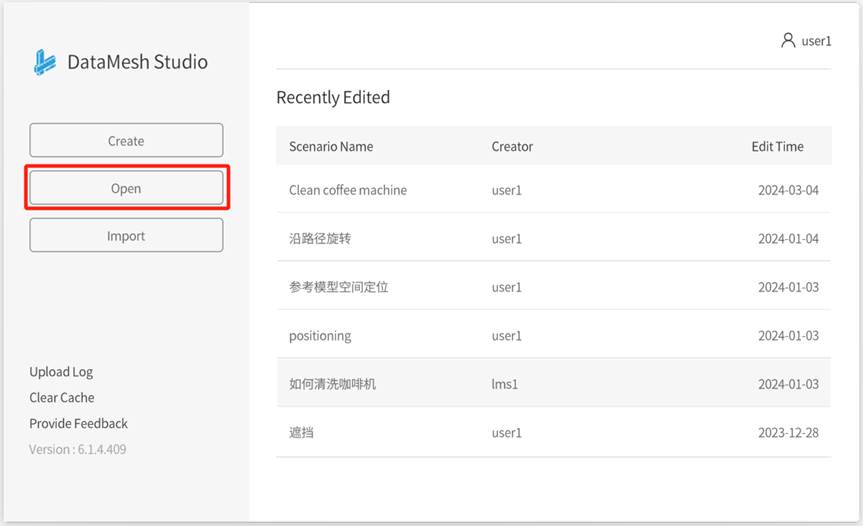
2. In the Open Scenario window, select a cloud scenario and click Open.

If you are editing a scenario, you can open a cloud scenario by clicking the File menu and selecting Open Scenario. Note: In this situation, you will be prompted to save the currently edited scenario.

Save a scenario
To save a scenario to the DataMesh FactVerse platform, follow these steps:
1. In the editing interface of DataMesh Studio, click the save button ![]() , or go to the File menu and select Save.
, or go to the File menu and select Save.
2. If this is your first time saving the scenario, you will be prompted to enter a scenario name, select a storage path, and click the Confirm button in the Save Scenario window to save the scenario.

Import a local scenario
To import a local scenario into DataMesh Studio, please follow these steps:
1. On the homepage of DataMesh Studio, click the Import button. This will open a window displaying your local resources.

2. In the local resources window, locate and select the scenario file you want to import, then click the Open (O) button.
3. In the open window, select the path where the scenario resources (model files, images, audio, etc.) are stored. The scenario resources will be stored in the FactVerse resource library according to the original scenario directory structure.
4. Click Confirm to complete the import of resources within the scenario.
5. In the editing interface of DataMesh Studio, the scenario will be automatically loaded and opened. You can browse, edit, and save this scenario.
Export a scenario
To export a scenario, follow these steps:
1. Click on the File menu and select Export Scenario. This will open the Export Scenario window.
2. In the Export Scenario window, you can configure the export options by choosing between Export Basic Scenario, Export Full Scenario and Export Accelerated Scenario.

-
- Export content: Exports a .dirpkg scenario index file along with the associated resource files. This option generates smaller files but requires resource acceleration again during import.
- Accelerated attachment: Exports the scenario with accelerated attachments included. These resources are ready to use upon import, but the upload process will take longer compared to the default export option.
Play (preview) a scenario
DataMesh Studio supports three play modes:
-
- Start from Beginning: In the editing interface, you can play the entire scenario using the following methods:
- Click the Preview menu and select Start from Beginning.
- Click the first scene thumbnail to set it as the current scene, and then click the play button
 .
.
- Start Preview: In the editing interface, you can play the scenario starting from the current scene using the following methods:
- Select a scene thumbnail and click the play button
 .
. - Click the Preview menu and select Start Preview.
- Select a scene thumbnail and click the play button
- Current Scene Only: In the editing interface, select a scene, click the Preview menu, and select Current Scene Only to play the currently selected scene only.
- Start from Beginning: In the editing interface, you can play the entire scenario using the following methods:
The scenario will be played in full screen. Press Esc on the keyboard or click the close button in the top right corner of DataMesh Studio to exit the play mode.
Change rendering environment
The rendering environment refers to the background lighting effects used to simulate light propagation, reflection, and refraction in the virtual environment. It influences the appearance, lighting, and shadow effects of objects, enhancing the overall realism and fidelity of the scenes.
In DataMesh Studio, you can choose either the built-in rendering environment or customize the rendering environment for scenario creation, making the virtual scene realistic and immersive.
To change the rendering environment of a scenario, you can follow these steps:
1. Click on the Scenario menu and select Change rendering environment from the dropdown menu. You can open the Change rendering environment window.

2. In the Change rendering environment window, you can choose the system-built rendering environments. When you choose “None,” there is no specific environment rendering effects.
You can also create a custom rendering environment to suit the scenario’s background and sky effects for different scene requirements and creative purposes.
Steps for custom reflection environment:
1. Prepare six images: These images should correspond to the front, back, left, right, top, and bottom directions of the rendering environment. The images should be in PNG format and follow English naming conventions (Front, Back, Left, Right, Top, Bottom).
2. Compress these images into a zip file and change its extension to .dmcm.
3. Upload this .dmcm file to the resource library on the DataMesh FactVerse platform.
4. In DataMesh Studio, click on the Scenario menu and select Change rendering environment from the dropdown menu to open the Change rendering environment window.
5. In the Change rendering environment window, select the Custom tab and click Select rendering environment.

6. In the window for Select rendering environment, find the uploaded .dmcm file.
7. After selecting the file, click the Confirm button to complete the customization of the rendering environment.
Manage scenario structure
In DataMesh Studio, the table of contents is used to display a list view of the structure of scenes chapters in the current scenario.
By clicking the table of contents button ![]() , you can browse the entire scenario, grasp the overall structure and chapter contents, and quickly jump to the desired chapters and scenes.
, you can browse the entire scenario, grasp the overall structure and chapter contents, and quickly jump to the desired chapters and scenes.


The following are the basic operations of the scenario structure:
-
- Start New Chapter: Each chapter in the table of contents represents a group of scenes. To start a new chapter, you can right-click on a scene in the timeline, select New Chapter, and a window will appear. Type in the chapter’s name, and this will make the selected scene a starting point for a new chapter.

Keep Elements: This option is a checkbox found in the New Chapter window that toggles whether or not you keep the elements from the previous scene. When checked, all the elements remained where they were. When unchecked, this converts the scene into a completely blank slate by removing all of its elements.
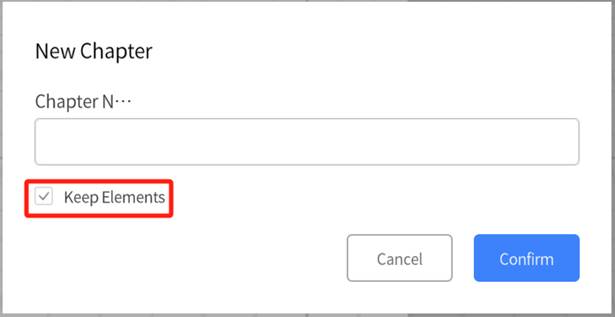
-
- Delete Chapter: To delete a chapter, right-click on the chapter name in the timeline and select Delete Chapter. This will remove the chapter and all its associated scenes from the table of content.
- Rename Chapter: To rename a chapter in the scene catalog, right-click on the chapter name in the timeline and select Rename Chapter.
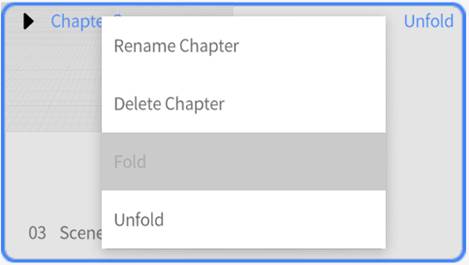
Create multilanguage scenario
DataMesh Studio supports users to add multi-language text content to scenarios, thus creating multi-language scenarios. When playing scenarios in DataMesh One, the text content in the scenario will be presented according to the interface language. The multi-language text feature supports the following languages: Simplified Chinese, English, Traditional Chinese, and Japanese.
Multilanguage scenario title
You can add multilanguage text content to the scenario title using the following steps:
1. Click on the Scenario menu and choose Rename.

2. In the scenario title editing box, enter the scenario title.

3. Click on the multi-language icon ![]() in the scenario title editing box to open the Multi-language text window.
in the scenario title editing box to open the Multi-language text window.
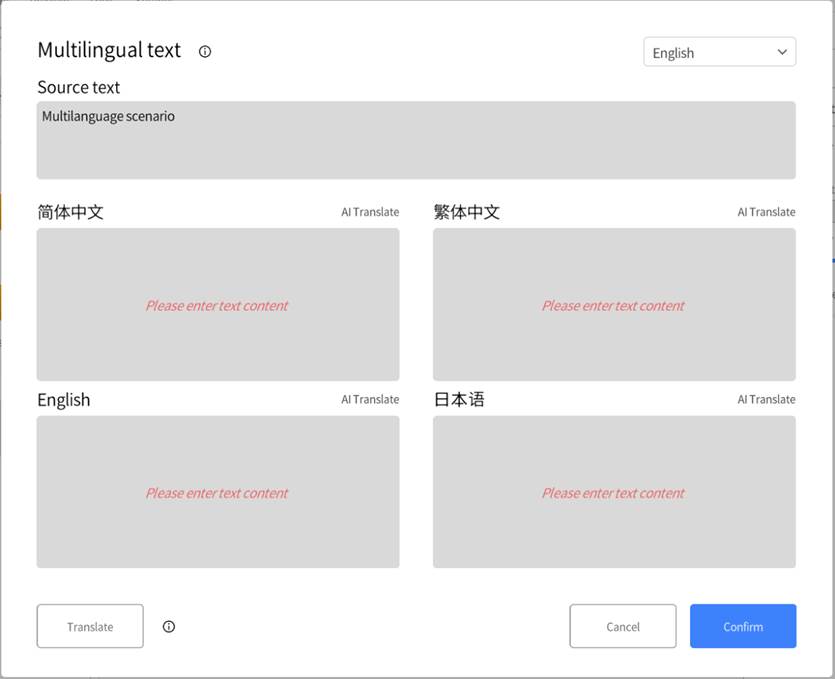
The language list in the top right corner of the Multilanguage text window displays the source text language. You can switch the source text language using this language list.
4. Enter the source text and multilanguage text content for the scenario title.
a) Users with FactVerse AI permissions can use the AI Translate function to separately translate the scenario title into the four languages or use the Translate function to quickly translate the text content into the four languages.
Note:
-
- Using the AI translation function consumes a certain number of tokens for each translation in each language. The number of tokens consumed is based on the length of the content.
- Using the Translate All function only consumes tokens for non-source text languages. The number of tokens consumed is based on the length of the content. Text boxes that are the same as the source text language directly display the source text content, so no tokens are consumed.
b) Users without FactVerse AI permissions need to enter text content manually.

5. Click Confirm to save the multi-language text content of the scenario title.
Note: When playing the scenario, the scenario title content displayed will match the interface language of the playback device. If a certain language content is empty, no content will be displayed during playback.
Multilanguage scene name
To add multilanguage names to scenes, please follow these steps:
1. Without selecting any elements, choose the scene you want to edit from the timeline.
2. In the attribute pane, click the edit icon ![]() next to the scene name.
next to the scene name.

3. Click the multilanguage icon ![]() in the scene name editing box to open the Multilanguage text window.
in the scene name editing box to open the Multilanguage text window.

4. In the Multilanguage text window, enter the source text and multi-language text content for the scene name.

5. Click Confirm to save the multilanguage text content for the scene name.
Other multilanguage text content
Apart from the scenario title and scene name, users can also add multilingual text content to the following sections:
-
- Chapter name: In the window for creating or editing chapters, click the multilingual icon
 to open the multilingual text window and add multilingual text to the chapter name.
to open the multilingual text window and add multilingual text to the chapter name.
- Chapter name: In the window for creating or editing chapters, click the multilingual icon

-
- Textbox content: Click the ellipsis icon
 in the top right corner of the textbox content editing box, select the multilingual text option, open the Multilingual text window, and add multilingual text to the text box content.
in the top right corner of the textbox content editing box, select the multilingual text option, open the Multilingual text window, and add multilingual text to the text box content.
- Textbox content: Click the ellipsis icon

- Tag text: Click the ellipsis icon
 in the top right corner of the tag text content editing box, select the multilingual text option, open the multilingual text window, and add multilingual text to the tag text content.
in the top right corner of the tag text content editing box, select the multilingual text option, open the multilingual text window, and add multilingual text to the tag text content.

- Button text: Click the ellipsis icon
 in the top right corner of the button text content editing box, select the Multilingual text option, open the Multilingual text window, and add multilingual text to the button text content.
in the top right corner of the button text content editing box, select the Multilingual text option, open the Multilingual text window, and add multilingual text to the button text content.

Scenario positioning
By default, scenarios are usually positioned using the model on the first page. DataMesh Studio also offers two additional positioning methods: reference model positioning and QR code positioning.
Reference model positioning
Reference model positioning refers to using one or more reference models to assist with scenario editing and spatial positioning.
The specific steps for using reference model positioning are as follows:
1. To enter reference mode, select Scenario > Modify Scenario Positioning from the toolbar.
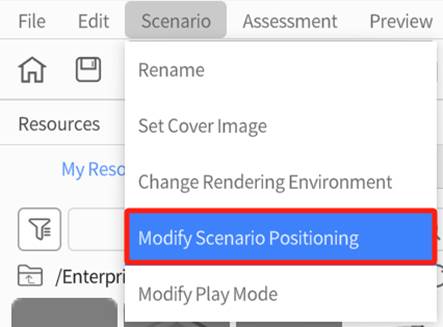
2. Find the model you would like to use as your reference model in the resources pane, then drag it into the workspace. In reference mode, you can freely position and adjust your reference model.

3. Once you are done, click the Quit button at the top right of your workspace to exit reference mode.

4. Play the scenario in DataMesh One and use joystick position scenario.
Note: In DataMesh One, the Position Reference setting needs to be set to First Frame, aligning with the first frame of the first scene in the script for positioning.

5. Click ![]() to complete positioning.
to complete positioning.

QR code positioning
QR Code Positioning aligns virtual scenarios with real-world spaces precisely through scanning or anchoring. Here’s how to add, edit, and delete markers in DataMesh Studio:
Managing markers in scenarios
1. Enter positioning mode: Click the Scenario menu in the menu bar and select Modify Scenario Positioning from the dropdown to enter positioning mode.
2. Add markers: New scenarios include a default marker named “Marker_1.” When no elements are selected, you can add a new marker by clicking Add Marker in the attribute panel. Each click adds a new marker to the scene along the X-axis at 5-decimeter (dm) intervals.

In DataMesh Studio versions 5.6 and up, the maximum number of markers you can add is 20. Otherwise, you can only add up to 10.

3. Edit markers: Select a marker to view its details in the attribute panel, including:
-
- Position: Manually adjust the 3D spatial position of the code.
- Rotation (Y): Modify the Y-axis rotation angle.
- Preset: Quickly adjust the orientation of the code via the attribute panel.
4. Delete markers: Select a marker and click the Delete button  in the toolbar to remove it. Note: Each scenario must retain at least one marker.
in the toolbar to remove it. Note: Each scenario must retain at least one marker.
5. Exit positioning mode: Click the Exit button to leave positioning mode.
You can scan the marker in DataMesh One for precise alignment of virtual models with real-world spaces or use the anchoring feature for positioning. For detailed instructions, refer to the DataMesh One User Manual.